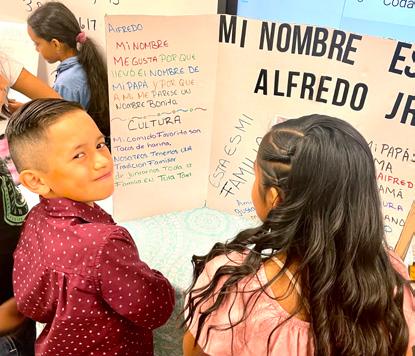
3 minute read
Family STEAM Night

The GISD STEAM night in November was a wonderful success for our families in the Gainesville community. Students of all ages were invited to attend the event, and more than 400 participated in the fun! Upon entering, students picked up a “passport” that outlined the location of the 14 hands-on, creative stations, including two activities hosted by the University of North Texas Engineering department. The district provided hot dogs, Frito pies, cookies, and drinks for all those in attendance.
Advertisement
According to the Department of Commerce, STEM-related careers worldwide are predicted to grow 24% compared to other types of occupations. STEM careers today provide a higher salary vs. non-stem jobs. Increasing STEM education in GISD creates critical thinkers and problem solvers, so our future leaders are prepared with the skills needed to lead as innovators. • A chemistry activity producing a take-home lava lamp using vegetable oil, water, food coloring, and reactive antacid tablets. • An apple pie sensory station promoting math for our younger-aged students where they had to follow the recipe to put apples, cinnamon sticks, and oats in their pie pans in the correct amounts. • A creative engineering station where students assembled boats out of foil and were asked questions about their designs, and they tested their designs in water. • A team of four faculty and graduate students from the Institute for the Integration of Technology into Teaching and Learning (http://iittl.unt.edu) in the Department of Learning Technologies at the University of North Texas hosted hands-on learning engagement activities developed as part of the NASA Space Science Education Consortium (NNX16AL63A, 2016-2022). IITTL Co-Director Dr. Gerald Knezek, Research Associate Dr. Samson Lepcha, Ph.D. candidate Anila Das and doctoral student Samantha Norton guided standing-room-only lines of GISD students and their families through piloting drones to a simulated landing on Mars. They used virtual reality through the Mission: ISS application to explore the International Space Station with a simulated feeling of a sense of weightlessness similar to what astronauts feel and experience in how to move and work in zero-gravity, use space tools, dock a space capsule, and take a spacewalk. Contributed by Anila Das, UNT Ph.D. candidate. • Titans of Space, another virtual reality application, allowed students to explore a holographic replica of the Solar System and travel to the planets and the sun and beyond to some of the greatest stars in the universe. Augmented reality with the

A STEAM night is a family gathering of fun that incorporates science, technology, engineering, art, and math learning opportunities in a creative and collaborative environment.
Some of our stations included:
Spacecraft AR app on iPads gave students a realistic sense of driving rovers on Mars and using spacecraft to bring explorers to other parts of the solar system. Approximately 400 informal learning participants spanning all ages from pre-kindergarten to grandparents experienced at least one of the technology-based space science applications. — Contributed by Anila Das, UNT Ph.D. candidate.
Each station had volunteers from our Gainesville High School National Honors Society, Key Club, and Student Council. The dedication of their efforts was impressive, and they were fantastic mentors to the younger students. These future leaders guided the participants with problem solving-questions and steps during the experiments.
We look forward to seeing more of our community attend the next STEAM night!

















